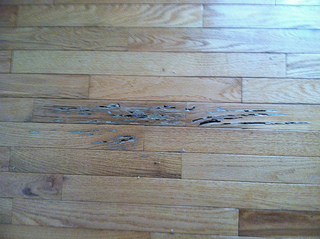Termites in the Floor
By Chris Williams on April 23, 2015.

Welcome. I’m Zack Ciras from Colonial Pest Control, your go-to full service pest control company serving Central and Eastern Massachusetts, Southern New Hampshire, and Southern Maine. Today, I’d like to answer a few questions about a possible termite infestation in wood floors.
So, how does one tell whether or not there really are termites in your floor? What are the signs? Some signs of termites in the floor can be seen. Others can be heard. Squeeky floors may inspire curiosity and further inspection. Tapping a tool such as the butt end of a screwdriver against the floor and baseboards might indicate some damage by the sound it produces. If there’s a hollow sound, or a paper like crinkle, that might lead you to look deeper in that area.
Termites travel in mud tubes to and within their food source. Upon inspection, flecks of mud can be seen within damaged wood. There may be small, oblong opening into the wood, or even galleries and channels along the grain of the wood. Within the mud tubes, if cracked open, may be seen small off white termites working away.
In the spring, swarms of blackish reproductive termites emerge and drop their wings en route to start a colony of their own.
Is there a certain type of wood floor that is more attractive to termites?
Studies have been done in terms of wood more susceptible to a termite infestation. The Eastern Subterranean Termite tends to prefer loblolly pine and slash pine. Some wood such as juniper, redwood, and cypress is less preferred, but honestly, no wood is safe under the right conditions for termites. Moisture, proximity to the ground, and control measures have more to do an infestation than the wood type.
After an infestation, can the floor be made resilient to termites without being completely replaced?
Controlling the access and attractive moisture in addition to an ongoing pest service is the best way to go. Borate treatments to the wood help to preserve it as well. The holistic control efforts to control termite populations around your home will in turn protect the floor, and that’s the best way to think of it.
What about the foundation? Will termites in the floor effect the foundation?
Since we are talking about subterranean termites in New England, we must appreciate the fact that, in most cases, termites in the floor will already have been in the sill of the house on top of the foundation. The stone or cement structure of the foundation is more likely to assist in causing the problem than being affected by it. There’s nothing in it for the termites to eat, but it may allow them access to the wood they prefer to consume.
And now the question of many do-it-yourselfers looking to handle termites on their own, can I do it, or would it be too difficult?
In my professional opinion, many pest issues can be maintained by a thoughtful homeowner given the time and research, but termites are special. The complicated nature of the pest and the many variables which may contribute to a termite infestation is in itself reason for professional help. Many of the best materials and the tools with which to apply them are available to professionals and may be difficult to handle. For a termite problem, or for best prevention, I suggest going with a true pest professional.
Give us a call at 1-800-525-8084 or visit us at colonialpest.com.
For Colonial Pest Control, I’m Zack Ciras. We’ll catch you next time.
Photo credit: Apple Realty / Foter / CC BY-SA